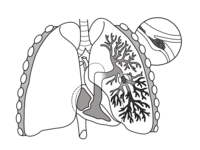
Photo from wikipedia
The recent adjunctive catheter-directed thrombolysis (ATTRACT) trial rose a controversy about the treatment effect of catheter-directed thrombolysis (CDT) in deep venous thrombosis (DVT). In fact, most studies including the ATTRACT… Click to show full abstract
The recent adjunctive catheter-directed thrombolysis (ATTRACT) trial rose a controversy about the treatment effect of catheter-directed thrombolysis (CDT) in deep venous thrombosis (DVT). In fact, most studies including the ATTRACT trial did not perform subgroup analysis of catheterization approaches. Different approaches would confound the conclusions. Therefore, a single-center retrospective analysis was performed to compare the differences between the antegrade (AGA) and retrograde (RGA) approaches. Total 217 DVT patients treated with CDT were enrolled from January 2010 to December 2017, with mean age of 55.3 years (67 received antegrade approach, 150 received retrograde approach). The clot burden reduction by segment was evaluated. The mean access establishment time and thrombolytic time were compared. The patency of the iliofemoral vein at 6 months was evaluated. The rate of PTS, quality of life and venous insufficiency were assessed at 1 year. AGA group showed better thrombolytic effect in popliteal and femoral vein than RGA group. The rate of iliofemoral clot burden reduction in RGA group was mostly at Grade II, while most were at Grade III in AGA group. The retrograde approach showed better thrombolysis effect in iliofemoral DVT than popliteal to iliac DVT. The RGA group reported longer mean access establishment time (5.4 ± 1.8 vs 27.0 ± 7.5 min, p < 0.001) and thrombolytic time (6.9 ± 1.5 days vs 6.8 ± 1.5 days, p = 0.586). At 6 months, RGA group had a lower rate of femoral vein patency (52.0% vs 89.6%, p < 0.001) and a higher rate of venous insufficiency (52.0% vs 29.9%, p < 0.001), compared with AGA group. Although there was no difference in the rate of PTS, the RGA group showed higher Villalta scores in the free and mild PTS. The antegrade approach was preferably recommended over the retrograde approach for CDT treatment.
Journal Title: Journal of Thrombosis and Thrombolysis
Year Published: 2020
Link to full text (if available)
Share on Social Media: Sign Up to like & get
recommendations!